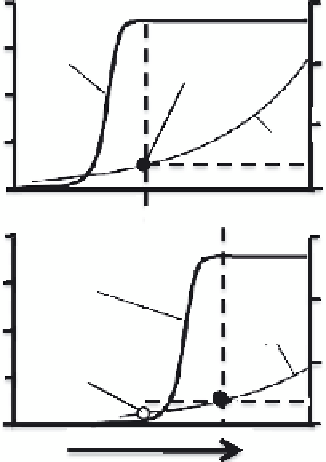Biology Reference
In-Depth Information
1
Control
1.5
Behavioral
response
Sensory response
No longer su�cient for
behavioral response
0.75
1
0.5
0.5
Olfactory
response
0.25
0
0
1
Copper
1.5
Necessary input shifts
Behavioral
response
0.75
1
Olfactory
response
0.5
Sensory response
No longer su�cient for
behavioral response
0.5
0.25
0
0
Log stimulus concentration
FIGURE 10.2
Conceptual model illustrating how shifts in olfactory sensitivity can result in corresponding shifts in predator
avoidance behavior. In unexposed fish, a threshold concentration of alarm pheromone (left vertical dashed line)
is required to generate an olfactory response (horizontal dashed line) that will be sufficient to trigger an alarm
response. Following exposure to copper, a shift in olfactory sensitivity increases strength of stimulus needed
to reach this physiological and behavioral threshold (right vertical dashed line), and the previous stimulus now
effectively fails to elicit alarm behavior. (After Sandahl, J.F. et al.,
Environ. Sci. Technol.
, 41, 2998-3004, 2007. With
permission.)
Such detrimental effects can occur at low doses. Chronic exposure to (relatively) low
concentrations of waterborne cadmium (0.2, 2.0, and 20 μg L
-1
) during embryonic and lar-
val development was claimed to result in the long-term hindrance of antipredator behav-
ior in zebrafish
Danio rerio
(Kusch et al. 2008). Olfactory toxicity has been observed, for
instance, in coho salmon
O. kisutch
exposed to commonly used pesticides and certain sol-
uble compounds (glyphosate, iodocarb) at doses lower than guideline concentrations for
water quality in Canada (Tierney et al. 2006). Similarly, the sensory physiology of juvenile
coho salmon is significantly impaired by copper at concentrations as low as 2 μg L
-1
, a con-
centration commonly detected in stormwater runoff from urban landscapes (Sandahl et al.
2007). This copper-induced chemosensory deprivation has the potential to cause increased
predation mortality in exposed coho salmon via corresponding shifts in predator avoid-
ance (Figure 10.2).
10.2.2 Neural and Hormonal Mechanisms of Behavior
Behavioral mechanisms have been mainly studied in mammals and birds. However,
they include general characteristics that are highly conserved throughout evolution,
and others that are more diverse and comparatively specific to certain taxa. In their
review, Adkins-Regan and Weber (in Dell'Omo 2002) underlined that a number of traits
of vertebrate nervous system organization were remarkably similar from lamprey to

Search WWH ::

Custom Search